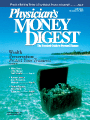Publication
Article
Physician's Money Digest
Should You Be Concerned with the AMT?
Author(s):
The alternative minimum tax(AMT) was originally designedto ensure that high-income taxpayerswould pay a reasonablelevel of income tax. The AMT sought toclose off special tax benefits to a part ofthe population that paid little or no taxes.But over the years, its impact has broadened.Back in 1970, only 19,000 taxpayersowed AMT. This number has grownto an estimated 2.6 million for 2002, andis projected to reach 35 million by 2010.
Computing the AMT
To determine the AMT's impact onyou, first compute your standard incometax liability. Next, determine your AMTliability. Under the AMT, a number of taxbenefits or deductions that you wouldnormally receive in computing your standardincome tax liability are reduced oreliminated. These include the personal/dependent exemption and standard deductionif you don't itemize, as well asstate and local income taxes, propertytaxes, and home equity loan interest.
Itemized deductions (eg, investmentand medical expenses) may be disallowed.Those who exercise incentivestock options are responsible for reportingas AMT income the differencebetween the exercise price and the marketprice at the time of exercise.
To compute your AMT liability, deductthe AMT exemption (ie, $58,000 for2003 joint filers). After the exemption isdeducted, the resulting amount is subjectto special AMT tax rates. The tax liabilityfor joint filers is figured at 26% on thefirst $175,000 and 28% on the excess.
After determining your AMT liability,compare it to your standard income taxliability. If the AMT liability is greater, thedifference is owed as AMT.
AMT Vulnerability
You're vulnerable to AMT if yourincome is over $75,000 and you take significanttax write-offs. The likelihood ofAMT liability increases if your returnincludes 1 or more of the following: alarge number of dependency exemptions;an unusually large deduction for state andlocal income tax; an exercise of incentivestock options; a large employee businessexpense deduction; interest on a mortgagenot used to buy, build, or improveyour home; and/or large capital gains.
If you believe you may be subject toAMT for 2003, run the numbers. Makepreliminary calculations and then consultwith tax advisors. You may be ableto take steps before year-end that willminimize liability.
David W. Keister is managingdirector and chief trust officer ofestate planning and trust administrationat Chevy Chase TrustCompany in Bethesda, Md. He welcomesquestions or comments at240-497-5007 or dkeister@chevychasetrust.com.
